Heating for next to nothing! Heat pump for home heating: the principle of operation of the device
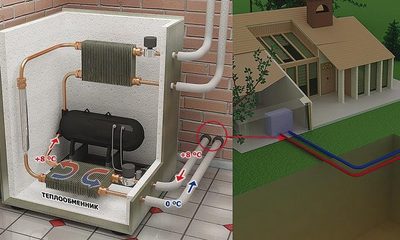
The heat pump is an alternative heating option in the form of a vapor compression unit. The device transfers warm air from cold heat sources to high-potential ones.
Energy is transferred due to condensation of the refrigerant and its subsequent transformation into steam. The refrigerant passes through a closed circuit during the operation of the heat pump. The heat pump spends electricity to condense the evaporation of forced circulation.
How does a heat pump for heating a house work?
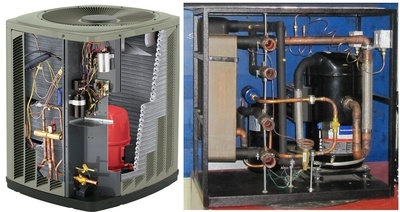
The installation consists of three components.:
- A probe designed to collect heat.
- TN and compressors.
- Condenser chambers with heating system.
Condenser or heat exchange chamber consists of pipes and radiators.
Probe — is a conductor through which heat is supplied. Probes depending on the operating principle and installation method are divided into 3 types:
- horizontal (placed in earthen trenches of depth from 1.2 meters and more);
- vertical (placed in wells of depth up to 200 m);
- water (placed in a reservoir below the freezing depth).
Heat pump consists of 6 components.
Coolant is part of the internal structure of the device. The component is directed for circulation in a closed circuit. In addition, the installation has capillary and compressor. There is in the pump evaporator, which heats the substance due to the cold temperature. Capacitor helps to retain heat for further use. The TN is located thermostat, which allows you to set the required temperature.
Reference. IN refrigerator The components are no different from a heat pump. However, the process is aimed at cooling. If the cooling is excessive, the system removes it to the rear wall of the device.
Types of heat pumps and their operating principles
The purpose of the TN is temperature exchange between carriers. There are several types of installations:
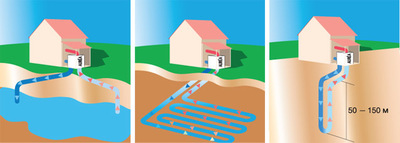
- land;
- aerial;
- water.
The installation supplies the building with heat from these natural energy sources. The principle of installation and operation of such pumps is somewhat different. The devices can be both open and closed type.
Soil-water
TN land type consists of 3 circuits. The external one is located in the ground. It collects thermal energy. The coolant enters the heat pump. Then the coolant passes into the evaporator. There the temperature begins to rise. The last circuit is presented in the heating system in a building or house. It is where water circulationBecause of this, the TN is called ground-water.
Attention! The heat carrier used in the installation under consideration is antifreeze or propylene glycol mixed with water. Otherwise, the substance is ethylene glycol.
Often in such a system the coolant is freonThis refrigerant is capable of transforming from a liquid to a gaseous state at low temperatures.
When the coolant boils, the vapors enter the condenser. Then the thermal energy enters the last circuit, where the water is. After the coolant cools, it is converted into a liquid state and passes into the ground circuit. The process is cyclical and constantly repeats itself.
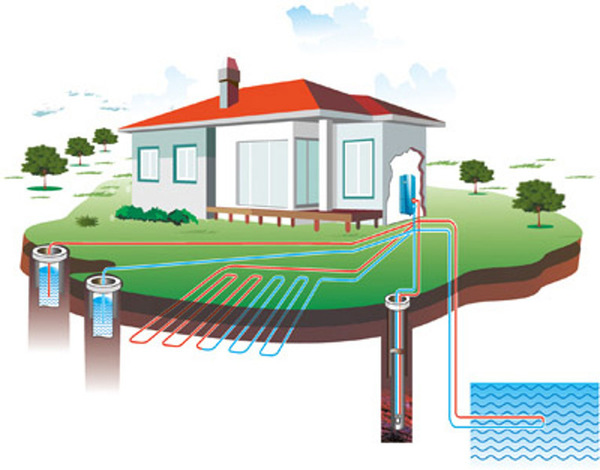
Photo 1. Schematic diagram of the design with a ground-water heat pump. The hot coolant is shown in red, the cold one in blue.
Water-water
The principle of operation of a water-type heat pump is to use low-temperature energy and convert it into heat. Water-to-water pump consists of 3 circuits. Freon acts as a primary heat exchanger.
Important! The contour is installed on the bottom of a natural reservoir. The depth is not less than 3 meters above the surface. The water does not freeze and does not fall below +3—5°С.
When the refrigerant circulates through the circuit, the substance is heated to 8°C. Then the coolant enters the unit body and the compressor. At this point, the freon is already in a gaseous state. When the coolant cools down in the building, it is converted into a liquid form. Then the substance passes into the first circuit. The process is repeated.
Water-air
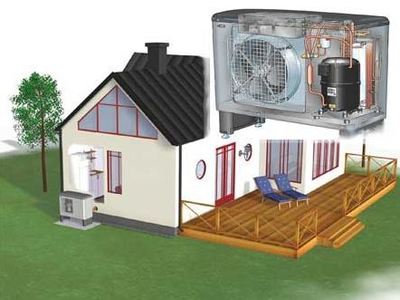
The operating principle of the heat pump, which operates in a water-air system, is similar to the system, like a refrigerator. The low air temperature begins to heat the freon, which is located in the first circuit.
The unit is connected to a heat evaporator and a condenser. In the heat emitter, the freon becomes liquid. During this process energy is transferred to the heating system.
In a liquid state, freon passes into the first circuit and evaporates again, turning into gas.
Air to air
Air-type TN works with the help of a fan. The device takes outside air into a circuit with an evaporator. It contains freon, which heats up and expands. The steam passes into the compressor and becomes warm. This happens due to the effect of increased pressure.
After the compressor, the freon enters the condenser. There, the substance loses thermal energy and cools down. The refrigerant becomes liquid and the resulting heat, which the condenser retained, used to heat the buildingWhen the freon has cooled, it returns to the evaporator and the process repeats.
To improve the efficiency of the heat pump, it is recommended to use a heat exchanger between the heat emitter and the evaporator. throttle valve. This heat generation cycle is called the inverse Carnot principle. To automate the process, control elements are included in the system.
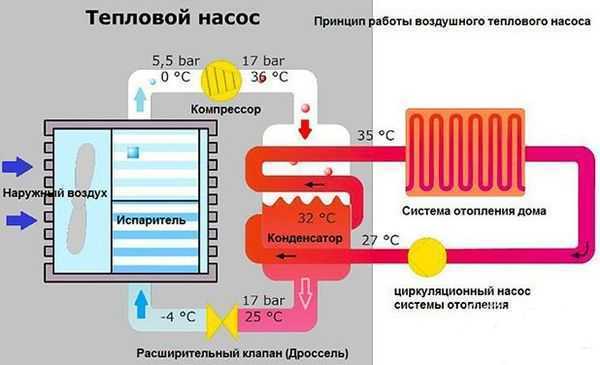
Photo 2. The device of the air-to-air heat pump. Freon is used as an evaporator.
Operation of the internal circuit
The internal circuit of any type of heat pump is the same in principle of operation. For heating or cooling a room use warm floors with water as a heat carrier. Internal heating consists of installing pipes or radiators in each room. Depending on the type of heat pump, the internal circuit acts as an air conditioner or fan coil.
The inner contour is a capacitor that radiates heat into the external environment.
Useful video
Watch a video that explains how a heat pump works.
Features of device operation
When choosing one or another type of heat pump, pay attention to the ease of use of the device. If the external circuit is in water, then its installation is suitable for private houses with a close location of a reservoir. In other cases, the TN can replace central heating in the apartment.







Comments
A very convenient thing. The water in the bath does not freeze, you do not need to drain everything every time.